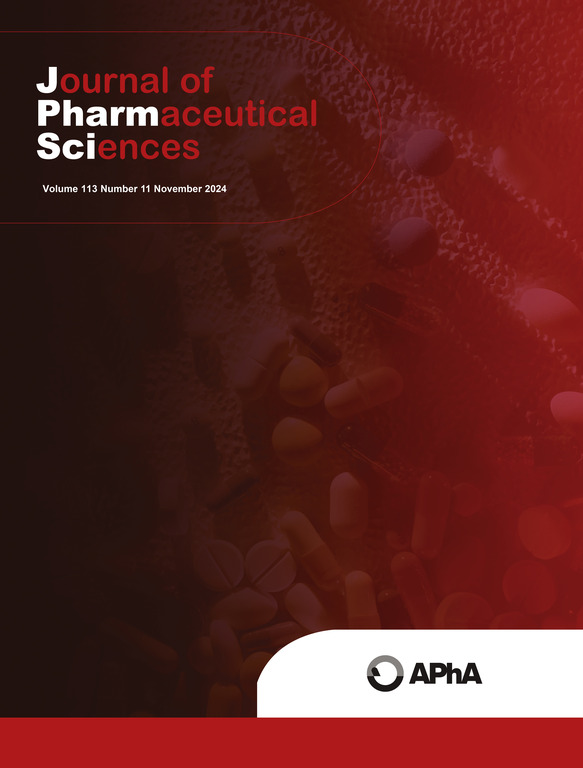ω-羧基端基纤维素酯是挑战性药物的有效结晶抑制剂
IF 3.7
3区 医学
Q2 CHEMISTRY, MEDICINAL
引用次数: 0
摘要
聚合物添加剂被广泛用于延迟药物从过饱和溶液中结晶,这对于通过无定形固体分散体(ASD)提高口服生物利用度至关重要。这些聚合物的功效取决于其抑制成核和随后晶体生长的能力。药物成核是结晶的关键;因此,有效的聚合物对于抑制过饱和溶液的成核至关重要。我们通过测量纤维素ω-羧基烷酸盐对过饱和溶液中难溶药物塞来昔布、泊沙康唑和恩扎鲁胺成核诱导时间的影响,研究了纤维素ω-羧基烷酸盐作为结晶抑制剂的性能。在没有聚合物的情况下,这三种药物都能在 5 到 15 分钟内结晶。聚合物的疏水性对结晶抑制效果有很大影响。疏水性聚合物可延长诱导时间长达 8 小时,而亲水性聚合物的效果较差,但醋酸纤维素戊二酸盐(CA1.18-GA1.21;取代度醋酸纤维素 1.18,戊二酸纤维素 1.21)除外。ω-羧基烷酸纤维素的玻璃化转变温度远高于 100 °C,非常适合 ASD 的稳定性要求。我们研究了这些设计聚合物对表面张力的影响,发现其对结晶抑制的影响很弱。在九种精心制作的纤维素衍生物中,水溶性 CA1.18-GA1.21 是一种非常有前途的 ASD 聚合物,它能在 2-8 小时内阻止所有快速结晶模型化合物的结晶。本文章由计算机程序翻译,如有差异,请以英文原文为准。

ω-Carboxyl terminated cellulose esters are effective crystallization inhibitors for challenging drugs
Polymeric additives are widely used to delay drug crystallization from supersaturated solutions, which is critical for enhancing oral bioavailability by amorphous solid dispersion (ASD). The efficacy of these polymers relies on their capacity to inhibit nucleation and subsequent crystal growth. Drug nucleation is pivotal to crystallization; therefore, effective polymers are essential for suppressing nucleation from supersaturated solutions. We studied the performance of cellulose ω-carboxyalkanoates designed as crystallization inhibitors by measuring their influence on nucleation induction times of poorly soluble drugs celecoxib, posaconazole, and enzalutamide, from supersaturated solutions. In the absence of polymers, crystallization occurred within 5 to 15 minutes for all three drugs. Polymer hydrophobicity strongly influenced effectiveness in crystallization inhibition. Hydrophobic polymers prolonged induction times for up to 8 hours, while hydrophilic polymers were less effective, except for cellulose acetate glutarate (CA1.18-GA1.21; degrees of substitution acetate 1.18, glutarate 1.21). The cellulose ω-carboxyalkanoates had glass transition temperatures well above 100 °C, outstanding for ASD stability requirements. We investigated the impact of these designed polymers on surface tension and found that it only weakly influenced crystallization inhibition. Among the nine crafted cellulose derivatives, water-soluble CA1.18-GA1.21 emerged as a highly promising ASD polymer, preventing crystallization for 2-8 hours for all fast-crystallizing model compounds.
求助全文
通过发布文献求助,成功后即可免费获取论文全文。
去求助
来源期刊
CiteScore
7.30
自引率
13.20%
发文量
367
审稿时长
33 days
期刊介绍:
The Journal of Pharmaceutical Sciences will publish original research papers, original research notes, invited topical reviews (including Minireviews), and editorial commentary and news. The area of focus shall be concepts in basic pharmaceutical science and such topics as chemical processing of pharmaceuticals, including crystallization, lyophilization, chemical stability of drugs, pharmacokinetics, biopharmaceutics, pharmacodynamics, pro-drug developments, metabolic disposition of bioactive agents, dosage form design, protein-peptide chemistry and biotechnology specifically as these relate to pharmaceutical technology, and targeted drug delivery.

 求助内容:
求助内容: 应助结果提醒方式:
应助结果提醒方式:


